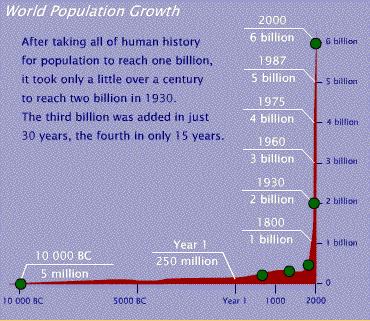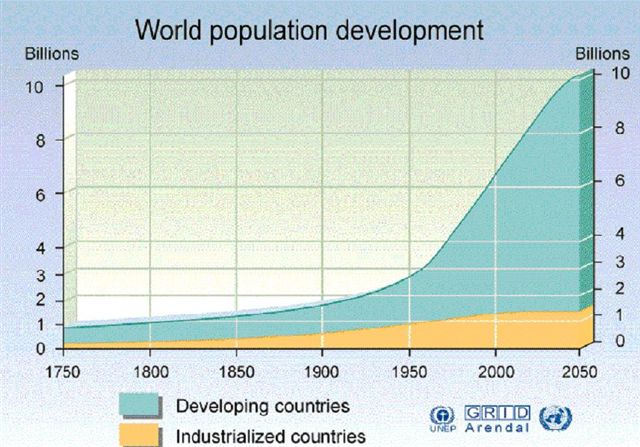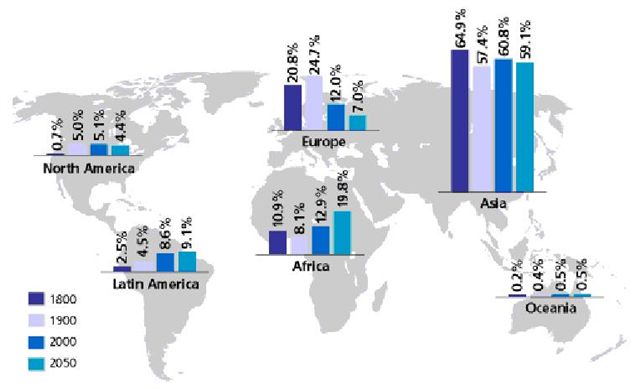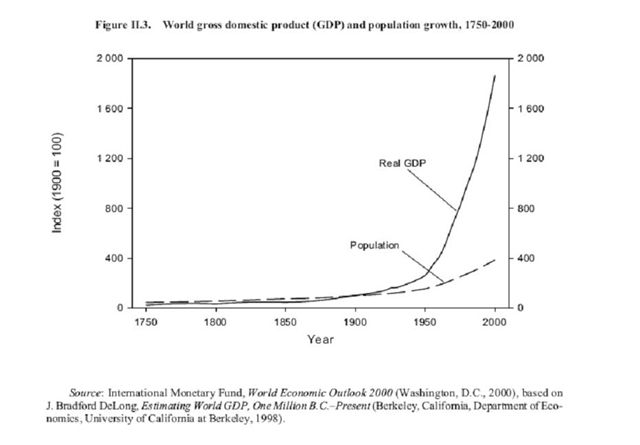Population Quickfacts
1. The size of the human population is one of the major factors which determine the total ecological impact of human activities (along with consumption levels and the technologies used, see Measuring Scale: IPAT).
2. Over the course of human civilization population was fairly stable, growing only slowly until about 1 AD. From this point on growth in the human population accelerated more rapidly and soon reached exponential proportions, leading to more than a quadrupling within the last century (UNFPA).
3. It took all of human history up to the early 1800s for world population to reach 1 billion people, and until 1960 to reach 3 billion. Today, the world gains 1 billion people every 11 years. (www.populationaction.org).
4. The current population of 6.4 billion people is almost eight and one half times larger than the population of 760 million at the beginning of the Industrial Revolution. At current growth rates, the world population could double in as little as 58 years.

This rapid increase in population parallels that of both increased GWP (GLOSSARY) and increased environmental degradation of global ecosystems (see other Areas of Concern).
5. Significant increases in human population are almost inevitable, with projections ranging from a high of almost 12 billion by 2050, to a low of just under 8 billion. Meeting the basic human needs of an additional 2 to 5.5 billion people over the next half century will place an increasing burden on the earth’s ecosystems, especially if global per capita consumption levels remain constant, or worse, continue to increase.
6. Population growth rates (GLOSSARY) have been dropping in all regions of the world since the 1970’s, and this trend is predicted to continue. Current expectations are that the human population will level off at about 8.9 billion people by 2050, and stabilize or slowly decline thereafter.
7. Future population projections are notoriously inaccurate; a difference of just 0.1% between predicted and actual growth rates translates into hundreds of millions of lives, and the census data on which the predictions are made are generally estimates only. These inevitable inaccuracies make planning for population increases difficult. Past projections have been notoriously inaccurate.
8. The globally declining population growth rate is due to a number of factors:
- Increased sanitation and health care
- Increased education and employment opportunities for women
- Later age at first parturition
- Availability of family planning and contraception.
9. A phenomena known as the “demographic transition” is also thought to contribute to a decline in growth rates. In the past, as societies became more prosperous there was an increase in levels of sanitation, nutrition and health care which led to a decrease in the death rate. The birth rate, however, generally continued for several decades and then also declined. The result of increased prosperity therefore initially resulted in an increase in population, but eventually led to a decrease. This was the pattern for what are now the major industrialized countries.
However the situation is somewhat different for currently developing countries, where the death rates are falling faster and further, and the gap between birth and death rates means a significant and rapid increase in population. At the same time, we are already exceeding the earth’s bioproductive capacity (see
Measuring Scale: Ecological Footprint).
10. The demographic transition identifies that there is a positive correlation between high incomes and low birth rates. However, there are also many exceptions to this relationship.[ fig 2-7 LtG] Birth rates can drop even with modest incomes as long as the economic gains are directed toward improving the educational level and health status of women, and making birth control easily available.

11. Despite the decline in overall population growth rate, the absolute size of the human population will continue to increase over the next several decades because of population momentum (GLOSSARY). Currently nearly one third of the world’s population is under 15 years of age and therefore has not yet reached childbearing age. Because this demographic group is so large in absolute numbers, even if each woman has fewer children than in the past, there will still be a significant increase in global population over the next several decades.
 12. Most of the population growth over the next several decades is expected to occur in developing countries, where growth rates are generally higher than for developed countries (1.5 to 2.1 % vs 0.2% for the most affluent countries). The United States is an exception, with one of the most rapidly growing populations of any developed nation (do we have a % for US???).
12. Most of the population growth over the next several decades is expected to occur in developing countries, where growth rates are generally higher than for developed countries (1.5 to 2.1 % vs 0.2% for the most affluent countries). The United States is an exception, with one of the most rapidly growing populations of any developed nation (do we have a % for US???).
Total World Population by Country Income Group, 1980, 1998, 2015

13. Not only will most of the population growth be in developing countries over the next several decades, but it is most likely to occur among the poorest communities in urban areas. Around 1800 only about 2% of the global population was living in urban areas; today more than 50% of the global population is urbanized and this is expected to grow. The number of megacities (with a population of 10 million or more) has grown from only 4 in 1975 to over 18 today and is expected to rise to at least 22 by as early as 2015. Urban populations have higher consumption levels for food, energy and other goods than do rural populations, and this trend will place an increasing burden on global ecosystems.
14. The international community generally agrees on the need for population control measures as reflected in the 1994 UN Cairo Conference on International Population. However, this position is not unanimous. Various groups are opposed to birth control in any form due to religious or cultural beliefs. Others contend that, due to human ingenuity, growth in human population enhances the potential for innovative solutions to be found to humanity’s problems.
15. Some of the contrasting views regarding population growth are economically motivated. An economic view sees population growth as integral to expansion of the economy and markets, and to providing cheap labour. Some governments also favor population growth as they believe a larger population means greater power, prestige and an expanded tax base. In terms of absolute expansion, population growth does tend to increase economic growth.
16. Economic growth is sometimes offered as the answer to poverty, one of the drivers of higher birth rates. As nations prosper their birth rates decline. However, the rate of economic growth has consistently exceeded the rate of population growth by a considerable margin over the past several hundred years, yet poverty has increased. These data clearly indicate that past economic growth did not reduce poverty, and there is little reason to expect further economic growth to lead to less poverty. Poverty, on the other hand, is associated with higher birth rates, as more children mean greater security in the light of economic uncertainty.
17. In contrast, “[t]here is clear evidence that enabling people to have fewer children, if they want to, helps to stimulate development and reduce poverty, both in individual households and at the macro-economic level.” (UNFPA report 2004 state of the world population at
http://www.unfpa.org/swp/2004/english/ch2/page3.htm.)
18. What is the earth’s carrying capacity for the human population? The answers to this question have ranged from a low of 500,000 to a high of tens of billions [Cohen – p 402-418]. Most of these estimates are little more than ideologically driven guesses. The question cannot be answered without considering consumption levels, and the technologies used to generate the consumption.
19. The Ecological Footprint data (see
Measuring Scale: Ecological Footprint) suggest that 3 – 4 planets with the earth’s bioproductive capacity would be required to support the current population at the consumption level of North Americans. Even more bioproductive land would be required to support a growing population that consumes at this level. This is clearly a physical impossibility with current technologies.
Either technologies must increase resource productivity by more than a factor of four, or consumption levels must decline, or population must decline. Population will increase over the next half century, so our only options are to radically improve the efficiencies of our technologies, and/or to significantly reduce our overall level of consumption.
20. The Millennium Ecosystem Assessment report in 2005 noted the degradation of global ecosystems, and indicated that continuation of current trends would make achievement of the Millennium Development Goals less likely. Notions of sustainable development are intricately tied to global population: the smaller the population in 2050, the easier it will be for all of humanity to achieve a respectable level of well being.